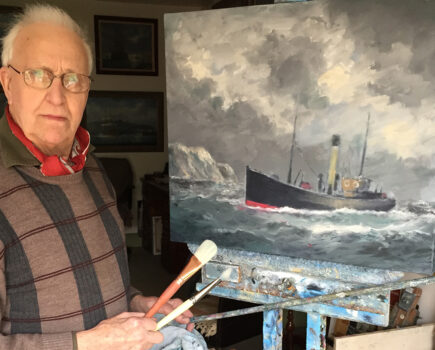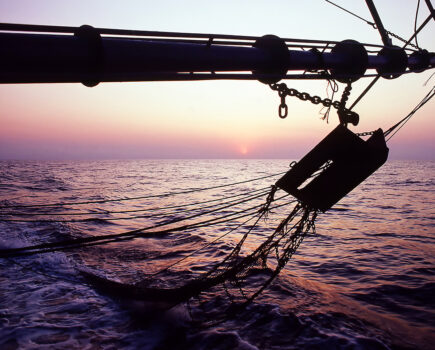Dr Magnus Johnson, senior lecturer in environmental marine science at the University of Hull, explores the growing spatial pressures on the industry as a result of offshore wind development – the topic of the latest meeting of the APPG on Fisheries
The All-Party Parliamentary Group (APPG) on Fisheries event ‘Fishing in a Changing Seascape’ on 30 November brought together MPs, policy-makers, fishermen and other marine stakeholders to talk about the impacts of offshore wind on fisheries.
The expectation is that 8% of the North Sea alone will be covered by wind farms by 2025, and potentially 15% by 2050 – this is an unprecedented industrial occupation of the seabed by a single industry. Other regions, including the Celtic Sea and waters north of Scotland, are similarly seeing a rapid growth in developments.
Many of the areas that offshore wind farms are planned for are prime fishing grounds. The biggest impacts of offshore wind farms are displacement of fishing effort and changes in the distributions of species – both of which increase the risk of competition and conflict between different fleets, and between static and mobile-gear users.
Construction can physically disturb spawning and nursery grounds, turbines can act as fish aggregation devices, and electromagnetic fields generated by the cables servicing them can change the behaviours of lobsters and rays.
These factors, which can reduce catches, are coming on top of increases in fuel prices that also restrict how far fishermen can go and how long they can spend at sea. The very presence of the wind farms will also restrict access by survey vessels, and so will impact on the ability of scientists to understand commercial species’ populations and advise on sustainable catch levels.
Cumulative impacts
It is clear that there is a real need for a better understanding of what the cumulative and long-term effects of offshore wind farms might be on fish stocks, and consequently on fishing fleets and coastal communities dependent on this source of income. Current knowledge is limited. It was suggested at the APPG event that the precautionary principle (i.e. that no action should be taken until it can be demonstrated that no harm will result) should apply to all industries in the marine space, not just fishing.
It is also evident that fisheries are facing a range of challenges in addition to offshore wind, such as the establishment of Marine Protected Areas (MPAs) and dredging. These need to be considered together, as they have cumulative impacts that may not be evident when they are considered piecemeal.
The NFFO and SFF estimate that 23% of the UK’s Exclusive Economic Zone is already off limits to demersal trawlers, and this could increase to 49% by 2050. Proposals by Natural England for strategic closures of fisheries to offset the potential impacts of offshore wind farms could compound these effects, unfairly disadvantaging the fishing industry.
Marine spatial planning involves several governmental and non-governmental bodies across and within jurisdictions in the UK, and there was agreement at the APPG meeting that there is a need for a more joined-up approach, and that the fishing industry needs to be closely involved.
One suggestion has been to designate specific areas for specific purposes such as wind farms or conservation – an approach that is reminiscent of single-species management of fish stocks. The distributions of species change year to year naturally, and will do so in the longer term in response to climate change, meaning that static spatial management techniques are unlikely to be effective. Fisheries Management Plans need to recognise these likely movements, and anticipate possible population shifts in the future.
There was general agreement at the meeting that there is a need for better data relating to species distributions, and that the fishing industry has a key role to play in gathering it. This will require building capacity and trust; there have been examples of fishermen working with government to gather data, only to find that this data has been used to prosecute them at a later date. In particular, there is a need for feedback loops so that fishing communities can benefit directly from their contributions.
Consultation overload
The sheer volume of developments is challenging for fishing industry organisations, as each one requires significant effort to understand any implications and provide a response. Overwhelmed with consultation opportunities, fishing communities are often fatigued and unable to respond at a point in the planning process when they can make positive contributions. They are instead often limited to fighting rearguard actions to limit the negative impacts of developments on their grounds.
Even when agreement is reached in advance, as happened with Scotland’s Marine National Plan, the fishing industry was disappointed to find that licences were granted to offshore wind farms in significant excess of what had been expected. While Marine Scotland and the MMO say they recognise the importance of consulting with the fishing industry, the industry is not a statutory consultee.
It was suggested at the APPG meeting that there is a need to involve the industry as consultees as early as possible with any developments, both for specific projects and at a broader strategic scale. It was clear that there is a need to recognise that consultation should not end once permission to proceed has been granted – consultees should be shown that their contributions have been taken into account.
Attendees at the event highlighted that the burden of responding to multiple ongoing developments and spatial designations should be minimised if affected fishermen are going to be able to respond effectively, which should involve consolidating consultations wherever possible.
Historically, different processes have been used for offshore wind and MPA spatial designations. This has resulted in missed opportunities for co-location, and has likely exacerbated the problems of spatial squeeze in some localities.
Co-location of offshore wind developments and the industry is possible, and some mobile and static-gear fishermen do work around offshore wind farms, but early consultation is necessary in order to optimise turbine and cable layouts. Even when the activities of fishing boats are taken into account, it may not be possible for fishers to access the grounds within an offshore wind farm for safety or insurance reasons.
Members of the fishing industry acknowledge the need to consider carefully all potential impacts on the environment on which they depend, more than any other stakeholder. With ongoing challenges to the industry such as growing numbers of offshore wind farms, fuel costs, crew shortages and other spatial exclusions, it is clear that, more than ever, the fishing industry needs to be an early, active and significant invitee to marine spatial planning discussions.
This story was taken from the latest issue of Fishing News. For more up-to-date and in-depth reports on the UK and Irish commercial fishing sector, subscribe to Fishing News here or buy the latest single issue for just £3.30 here.








